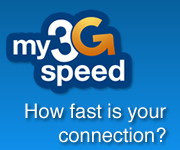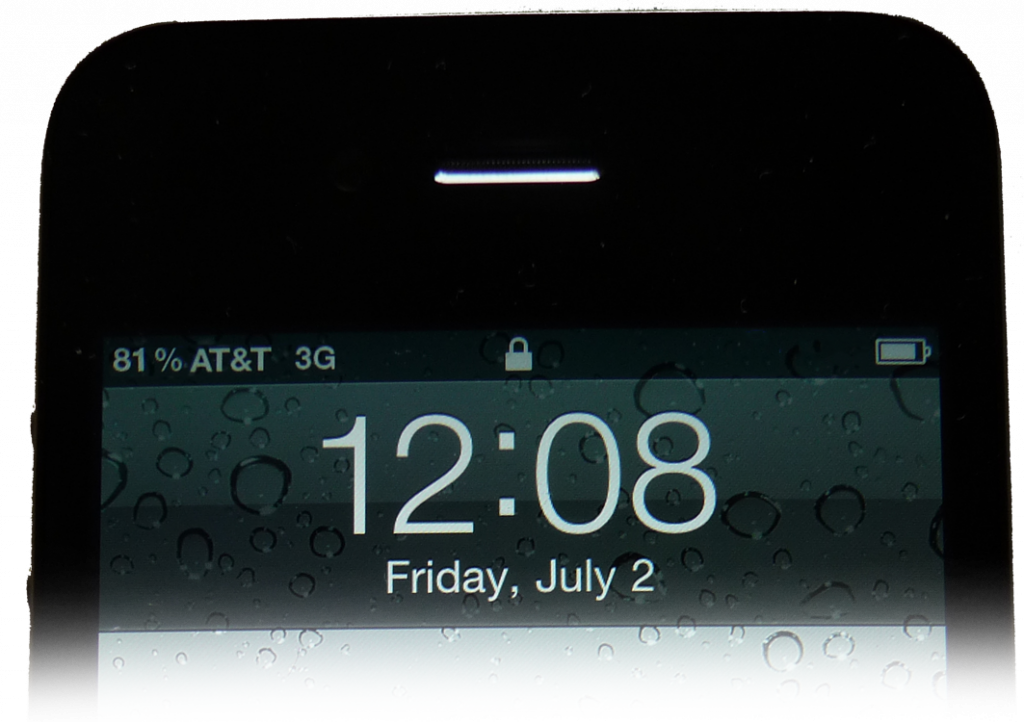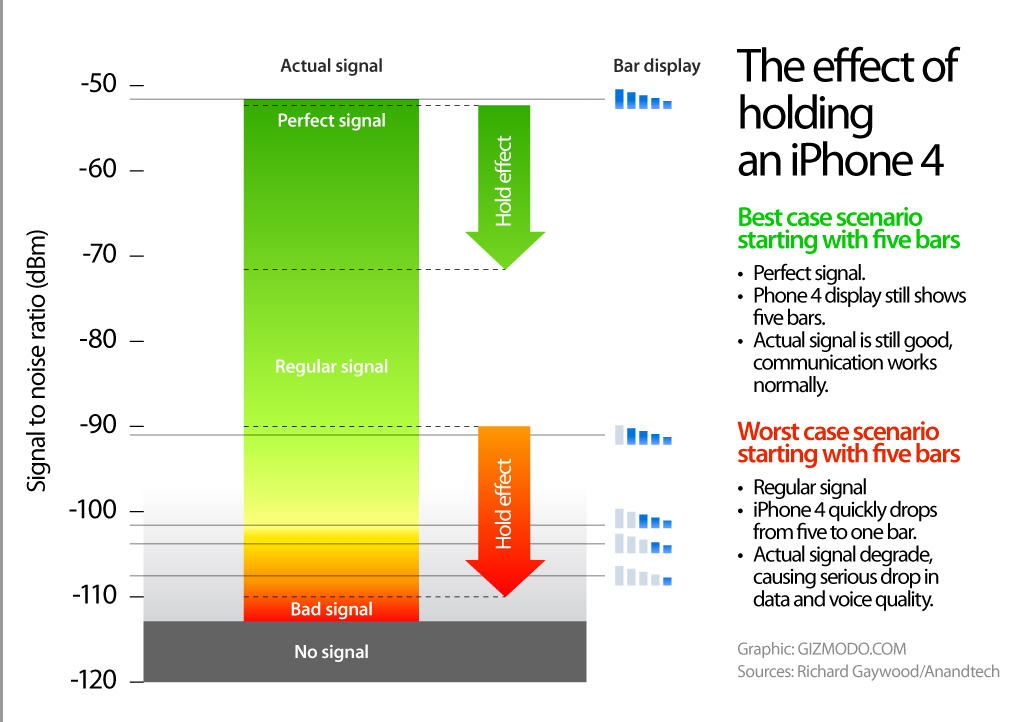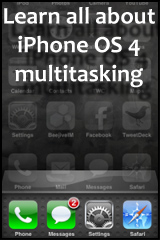Why not get rid of the bars?
by Justin Horn on Jul 2nd, 2010 @ 2:02 pmThe bars are there because people don’t need to know that they are at -63 dBs. I agree, that would be dumb and would be meaningless to most people, but why not just show it as a percentage of strength…like Apple does for the battery now.
The total range goes from -51 dB (best signal) down to -113 dB (lowest signal you can still make a call at). Let’s calculate the percent strength for entire range of dBs (step 2). Strength to Bars data from AnandTech.
% Strength = (Current Signal dB – low of dB range) / Total dB range
% Strength = ( (-51 dB) – (-113 dB) ) / ( (-51 dB) – (-113 dB)) = 100%
dB Signal % Bars -51 100% 5 -53 97% 5 -55 94% 5 -57 90% 5 -59 87% 5 -61 84% 5 -63 81% 5 -65 77% 5 -67 74% 5 -69 71% 5 -71 68% 5 -73 65% 5 -75 61% 5 -77 58% 5 -79 55% 5 -81 52% 5
dB Signal % Bars -83 48% 5 -85 45% 5 -87 42% 5 -89 39% 5 -91 35% 5 -93 32% 5 -95 29% 5 -97 26% 5 -99 23% 5 -101 19% 4 -103 16% 3 -105 13% 2 -107 10% 2 -109 6% 1 -111 3% 1 -113 0% 0
Using the percentage indicator it will never be the case, as it was with iOS 4.0.0 on iPhone 4, where 23% signal strength was represented by 5 bars!
Yeah, by showing numbers instead of bars, it does make it a bit more technical, but if someone is spending $300 on a phone I hope they know how percentages work. Plus, if you really miss your bars, there could be a toggle switch in the network settings, just like the battery in usage settings. Although, if enabled the bars should represent the underlining signal more fairly:
5 bars -> 80 – 100%
4 bars -> 60 – 79%
3 bars -> 40 – 59%
2 bars -> 20 – 39%
Hopefully this is what iOS 4.0.1 will do.
Follow me on Twitter @justin_horn
Apple responds to iPhone 4 reception issues, won’t actually fix anything
by Justin Horn on Jul 2nd, 2010 @ 10:14 amUPDATE John Gruber’s funny take on this: Translation From Apple’s Unique Dialect of PR-Speak to English of the ‘Letter From Apple Regarding iPhone 4’
Upon investigation, we were stunned to find that the formula we use to calculate how many bars of signal strength to display is totally wrong. Our formula, in many instances, mistakenly displays 2 more bars than it should for a given signal strength. For example, we sometimes display 4 bars when we should be displaying as few as 2 bars. Users observing a drop of several bars when they grip their iPhone in a certain way are most likely in an area with very weak signal strength, but they don’t know it because we are erroneously displaying 4 or 5 bars. Their big drop in bars is because their high bars were never real in the first place.
Translation, instead of going from 5 bars to 1 bar, you will go from 3 bars to 1 bar. This will not actually fix a problem that we all knew was hardware, it’s just adjusting the bars more evenly across the range of signal strength. Basically fixing my statement that not all 5 bars are not created equal, now the weak 5 bars will just show as 3.
So don’t get too excited, if you drop to 1 bar in hand, have crap 3G data speeds, and drop calls…nothing will change! This is just Apple trying to respond to this PR disaster.
Here is one way Apple really could fix the issue with software, I present my antenna software fix.
Don’t believe me? Take a look at the chart AnandTech put together showing the signal drop of the iPhone 4 compared to the 3GS.
Taking the bars out of the equation and working with the real signal, you can see the iPhone 4 is loses 10x more signal compared to a 3GS when held naturally in your hand. Add this to the fact that a bumper can bring this factor down to just a bit over 2x proves that touching the antenna is detrimental to the signal. This proves, that although this was Apple’s big product launch ever, it’s also the biggest hardware design disaster ever as well.
For all we know Apple found out about this hardware issue when it was too late to fix so they just tweaked iOS 4 to show a larger range of the signal in the 5 bar range to mask the problem.
Apple ends the open letter with the real solution to the problem:
As a reminder, if you are not fully satisfied, you can return your undamaged iPhone to any Apple Retail Store or the online Apple Store within 30 days of purchase for a full refund.
Apple, why can’t you just boost the signal output when it drops 20 dBs? I’ll take a battery hit in exchange for a decent signal!
Follow me on Twitter @justin_horn
So John Gruber is affected by iPhone 4 antenna issue
by Justin Horn on Jul 1st, 2010 @ 6:13 pmThis is a perfect example for all those people out there that think they are unaffected by the signal issue and the rest of us are exaggerating.
John Gruber of Daring Fireball has been saying he was unaffected by the issue and then later guessed it was due to a strong AT&T signal. This is also the conclusion I came to. Thanks to AnandTech’s breakdown of the bars to actual signal strength, we now know that the signal drop is affecting more people than we first thought, it just didn’t show up in the bars. I covered this in detail yesterday, so check that out first if you haven’t already.
Today John Gruber posted his 3G speed test comparisons for iPhone 4, iPhone 4 in hand, iPhone 3GS and iPad 3G:
Using the AnandTech findings yesterday, a natural (not death) grip in the left hand produced a drop of about 20 dB in signal strength. A 20 dB drop in the total range of -113 dB to -51 dB is a 32.6% drop in quality. Gruber’s iPhone 4 download speed went from 2.38 Mbps to 1.61 Mbps, a 32.4% drop. This drop is identical to the drop in signal strength recorded by AnandTech. So even if he had 5 bars on desk and in hand, it’s still the same drop in strength I and others are seeing.
Not sure why Gruber’s upload speed were unaffected, but could just be a fluke. In my testing I’ve noticed my upload speeds were affected more than the download when in hand. Also, you can see even with the degraded signal he is still doing a touch better than on the 3GS. This might have to do more with the smart tower selection built into the iPhone 4 than a raw speed improvement. This tower selection allows the iPhone 4 to pick a tower that may have weaker signal strength, but has less traffic, giving you an overall better connection.
The reason this is a big problem for weak signal areas is that you go from decent broadband speeds (about 1.5 Mbps) to dial up speeds (<500 Kbps) or worse, no connection at all. This is far more painful and detrimental to the over functionality of the iPhone than dropping from 2.38 Mbps to 1.61 Mbps.
Follow me on Twitter @justin_horn
This is how Apple will fix the antenna issue
by Justin Horn on Jul 1st, 2010 @ 12:31 amApple, just make that check out to Justin Horn…thanks!
Follow me on Twitter @justin_horn
The answer to why some don’t see the iPhone 4 bars drop in their left hand
by Justin Horn on Jun 30th, 2010 @ 10:39 am Image from Anandtech
Image from Anandtech
The short answer…it does, you just don’t see it in “the bars”.
I first thought this could be the answer way back on the June 24th during my bumper testing:
I then tested in another room with less electronics. In this room I started with a strong signal of 5 bars. This time around, with or without the bumper, the signal held pretty much at 5 bars. This may explain why some people don’t seem to notice this issue. If you have really great AT&T service where you live, the in hand signal drop may not be as noticeable.
After reading John Gruber’s post backing up my idea, I did a more specific follow up post on the issue:
I think the problem is “the bars”. They serve their purpose for the most part, but when trying to do a test involving signal strength we need more detail. I would argue that 5 bars in one area is not necessarily equal to 5 bars in another. Start with a “weak 5 bars” and you can see the signal loss represented by the bars dropping. Start with a “strong 5 bars” and the signal may be getting weaker, but never below the 5 bar threshold. In this case it appears to the user that they still have the same signal strength and it goes unnoticed.
Turns out the “not all 5 bars are created equal” was dead on. It was hard to prove this before because the old field test app that showed these numbers was removed from iOS 4. That didn’t stop Anandtech though, with a neat hack job they were able to get the numeric signal number back on iOS 4 instead of the bars:
However, you can see just how little dynamic range iOS 4 has for reporting signal; over 40% of the range of possible signal levels (from -99 dB to -51 dB) is reported as 5 bars.
They go on to test the drop in signal by how it’s held:
Tight grip in hand: 24.6 dB
Holding naturally in hand: 19.8 dB
Holding naturally with case: 7.2 dB
Open palm: 9.2 dB
Now let’s revisit my bars and bumper test with the dB numbers provided by Anandtech:
Strong 5 bars (Naturally held)
You start with the strong 5 bars at -60 dB (-51 dB would be strongest 5 bars), then you hold it in your left hand, lowering the signal to -79.8 dB (-51 dB – 19.8 dB). Even though you have a significant drop in signal, it’s still above the -99 dB threshold for 5 bars, so it goes unnoticed in the bars. If you did a speed test before and after, you would be able to see the difference…try it.
Weak 5 bars (Naturally held)
You start with the weak 5 bars at -90 dB (-99 dB would be weakest 5 bars), then you hold it in your left hand, lowering the signal to -109.8 dB (-90 dB – 19.8 dB). This now takes you past the 1 bar threshold of -107 dB. With 1 bar you can still make calls, but have a better chance of a drop. The bigger issue, at least for me, is the 3G data speeds drop dramatically.
Bumper (Naturally held with case)
I know I was starting with a signal that was on the lower end of 5 bars because every once in a while it would drop down to 4 bars. For this example let’s assume it was -95 dB. Holding naturally with the bumper it would drop down to -102.2 dB (-95 dB – 7.2 dB) putting it in the 3 bar range, exactly what I got during my test.
Another way to think about it in terms of bars would be to add 5 more bars on top of the 5 that already exist. Not as an average, but just adding more detail to the high end. The user that claim they don’t have an issue are really starting out with 9-10 bars in this 10 bar and dropping to 5-6, but those that start with 5 are dropping to 1.
So those of you that were counting yourself lucky are just starting off better, but when you aren’t holding your phone you still have a stronger signal.
Follow me on Twitter @justin_horn







